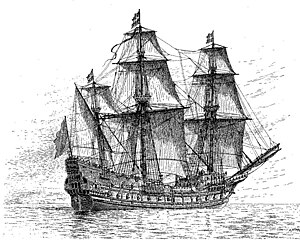Swedish warship Mars
 Depiction of Mars by Jacob Hägg.
| |
| History | |
|---|---|
| Launched | 1564 |
| Fate | Sank on 31 May 1564[1] |
| General characteristics | |
| Displacement | 1800 tonnes |
| Tons burthen | 700 tons |
| Length | Between Perpendiculars approximately 43 to 45 metres[2] |
| Beam | 45.5 Swedish Fot (13.7 metres) |
| Propulsion | Sails |
| Crew | 350 sailors, 450 soldiers |
| Armament |
|
| Notes | Source for dimensions & Tonnage: "Swedish Unrated Warship Mars (1563", Three Decks - Warships in the Age of Sail |
Mars, also known as Makalös ("peerless; astounding"), traditionally referred to as Jutehataren ("The Jute Hater"), was a Swedish warship that was built between 1561 and 1563.[3] She was the leading ship of King Eric XIV of Sweden's fleet and was one of the largest warships of the time. In 1564, during the Northern Seven Years' War, she caught fire and exploded during the First battle of Öland in the Baltic Sea.
Background[edit]
Eric XIV of Sweden succeeded his father, Gustav Vasa in 1560. He needed to consolidate the still-disputed independence of Sweden that had been achieved by his father, but was ambitious to build upon that. A strong navy could give Sweden the opportunity to tax foreign ships, so helping the economy. The keel of Mars was laid in 1561 and she was complete by the autumn of 1563, by which time the Northern Seven Years' War had broken out.
Mars was built during a time when both ship construction methods and naval tactics were undergoing change and development. Carvel construction had arrived in northern European waters during the previous century,[a] but this was not a single-step process and techniques were still being developed, as the archaeology of the wreck of Mars shows. The naval tactics of the time were moving from a focus on boarding to greater emphasis on stand-off gunnery to defeat the enemy. Again, this was a slow transition, ultimately producing the line of battle that became standard from c. 1672. At the time that Mars was built, the major maritime power of Europe (the Dutch) favoured close-range melee actions, with individual ships picking an opponent of roughly their own size.[3][4][5]
Battle of Öland: sinking[edit]
The First battle of Öland took place over two days, starting on the 30th May 1564. The first day went well for the Swedish fleet. They sank one Lübeckian ship and badly damaged the Danish flagship Fortuna. Both sides withdrew for the night to rest after the action, but when they re-engaged in the morning, the Swedish fleet had become dispersed due to bad weather overnight. Mars was attacked by several enemy ships and some incendiaries set her alight. Admiral Jacob Bagge, the Swedish commander ordered her colours to be struck. Mars was boarded, but the fire reached the magazine and she blew up in a massive explosion. Eye-witnesses described the foremast being projected into the air "like a cross-bow bolt". She sank very quickly.[3]
Wreck location[edit]
On 19 August 2011, it was announced that the Mars had been found at a depth of 75 meters and around 18.5 kilometers north of Öland, after several years of research.[6] Technical diver Richard Lundgren announced that "Everything suggests that it is indeed the Mars that we have found".[7]
On 1 November 2011 the shipwreck was confirmed to be Mars. According to Richard Lundgren, one of the divers who discovered the wreck, unique ship cannons had been identified along with "other findings" which confirmed the identity.[8]
See also[edit]
Notes[edit]
- ^ Carvel-built ships started to be used by the ship-owners of Europe's Atlantic coast in the 1430s. Carvel ships had visited this area from the Mediterranean in the preceding century. The earliest documented building of a carvel ship in England is dated to 1463-1466. The Danish crown had a carvel ship built in 1474 and the archaeologically-investigated Gribshunden was built in 1480 as another example of this technique. By the approach of the middle of the 16th century, most European powers were building warships in carvel construction.[4]
References[edit]
- ^ Lee, Jane (6 July 2014). "Cursed Warship Revealed With Treasure Onboard". Archived from the original on 7 August 2019. Retrieved 27 October 2020.
- ^ Eriksson 2019.
- ^ a b c Eriksson & Rönnby 2017.
- ^ a b Adams 2013, p. 71.
- ^ Lambert 2000, p. 41.
- ^ Martin, Rebecca (19 August 2011). "'New Vasa' shipwreck found on Baltic seabed". The Local. Retrieved 20 August 2011.
- ^ "Shipwreck of 16th-century Swedish vessel found in Baltic". Calgary Herald. Agence France-Presse. 20 August 2011. Retrieved 20 August 2011.
- ^ Holgersson, Jonatan (1 November 2011). "Mars är identifierat". Barometern (in Swedish). Retrieved 19 November 2011.
Bibliography[edit]
- Adams, Jonathan (2013). A maritime archaeology of ships: innovation and social change in late medieval and early modern Europe (1. ed.). Oxford: Oxbow Books. ISBN 978-1-84217-297-1.
- Eriksson, Niklas (3 July 2019). "How Large Was Mars ? An investigation of the dimensions of a legendary Swedish warship, 1563–1564". The Mariner's Mirror. 105 (3): 260–274. doi:10.1080/00253359.2019.1615775. Retrieved 9 June 2024.
- Eriksson, Niklas; Rönnby, Johan (March 2017). "Mars (1564): the initial archaeological investigations of a great 16th-century Swedish warship: MARS (1564) A 16TH-CENTURY SWEDISH WARSHIP". International Journal of Nautical Archaeology. 46 (1): 92–107. doi:10.1111/1095-9270.12210.
- Lambert, Andrew D. (2000). War at sea in the age of the sail: 1650-1850. London: Cassell. ISBN 0-304-35246-2.
